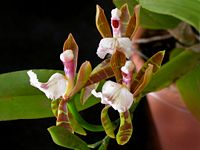Aspasia (orchid): Difference between revisions
imported>Dalton Holland Baptista No edit summary |
imported>Dalton Holland Baptista |
||
| Line 32: | Line 32: | ||
==Description== | ==Description== | ||
''Aspasia'' is a genus intermediate of ''[[Brassia]]'' and ''[[Miltonia]]'', to which it is morphologically closer and can be distinguished because its flowers show the [[labellum]] partially fused to the [[column (botany)|column]]. | |||
''Aspasia'' species are characterized for ofter showing am elongated [[rhyzome]], with thicker [[roots]] than ''Miltonia'', with more elliptical or elongated and highly laterally flattened [[pseudobulb]]s, protected by some foliar steaths shorter than the [[leaf|leaves]], and one or two apical leaves. These are narrow, thin and narrow, very malleable, light green colored. A [[inflorescence]] is erect or arching, shorter than the leaves and bares one or few flowers sometimes showy. The inflorescence shoots from behind the foliar steaths at the [[pseudobulb]]s bases. | |||
The [[flower]]s vary according to the species. The [[petal]]s from more elliptical to more acute, in some species wider than the [[sepal]]s, in others narrower or similar in size and shape, from flat to concave. The labellum is fused to the inferior half of the column, seeming to emerge from there and thereafter becoming much wider; the blade varies from slightly to clearly three lobed, flat or reflected, fleshier on the center and there showing calli or salient veins. The column is elongated, with or without small inferior auricles and present a large apical [[anther]] with two hard yellow [[pollinia]]. | |||
When these species are used to produce artificial hybrids, the characteristic that seems to predominate is the few amount of resulting flowers by inflorescence, prevailing even over the so floriferous ''[[Oncidium]]''. | |||
==Taxonomic notes== | ==Taxonomic notes== | ||
Revision as of 09:08, 21 March 2009
| Aspasia | ||||||||||||||||||||
|---|---|---|---|---|---|---|---|---|---|---|---|---|---|---|---|---|---|---|---|---|
 Aspasia epidendroides
| ||||||||||||||||||||
| Scientific classification | ||||||||||||||||||||
| ||||||||||||||||||||
| Type species | ||||||||||||||||||||
| Aspasia epidendroides Lindl. 1832 | ||||||||||||||||||||
| Species | ||||||||||||||||||||
| ||||||||||||||||||||
| Synonyms | ||||||||||||||||||||
|
Distribution
Aspasia exist in four different areas of Central and South America:
Two species inhabit primarily Central America the most common is Aspasia epidendroides, that ranges from Mexico to Colombia from sea level to 1,100 meters of altitude but much more common up to 400 meters; and Aspasia principissa, from Colombia to Costa Rica from sea level to 600 of altitude but much more common up to 150 meters. Also from exclusively from Colombia is Aspasia omissa. Aspasia psittacina, endemic in Ecuador, can be found from sea level to 750 of altitude but much more common up to 300 meters. Aspasia variegata is from all amazonic region from 200 to 1300 meters in Bolivia. The last area occupied is Brazilian southeast and south, reaching Bolivia and Paraguay, from 200 to 750 meters, by Aspasia lunata; and Aspasia silvana exclusively Brazilian Serra do Mar, from Rio de Janeiro to Bahia.
Description
Aspasia is a genus intermediate of Brassia and Miltonia, to which it is morphologically closer and can be distinguished because its flowers show the labellum partially fused to the column.
Aspasia species are characterized for ofter showing am elongated rhyzome, with thicker roots than Miltonia, with more elliptical or elongated and highly laterally flattened pseudobulbs, protected by some foliar steaths shorter than the leaves, and one or two apical leaves. These are narrow, thin and narrow, very malleable, light green colored. A inflorescence is erect or arching, shorter than the leaves and bares one or few flowers sometimes showy. The inflorescence shoots from behind the foliar steaths at the pseudobulbs bases.
The flowers vary according to the species. The petals from more elliptical to more acute, in some species wider than the sepals, in others narrower or similar in size and shape, from flat to concave. The labellum is fused to the inferior half of the column, seeming to emerge from there and thereafter becoming much wider; the blade varies from slightly to clearly three lobed, flat or reflected, fleshier on the center and there showing calli or salient veins. The column is elongated, with or without small inferior auricles and present a large apical anther with two hard yellow pollinia.
When these species are used to produce artificial hybrids, the characteristic that seems to predominate is the few amount of resulting flowers by inflorescence, prevailing even over the so floriferous Oncidium.
Taxonomic notes
Species
Aspasia epidendroides Aspasia lunata Aspasia principissa Aspasia omissa Aspasia psittacina Aspasia silvana Aspasia variegata